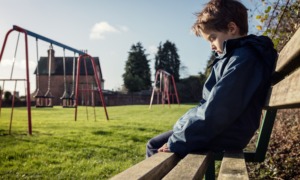A report released today by the nonpartisan child advocacy group Every Child Matters Education Fund shows that the deaths of 10,440 U.S. children in the seven-year period of 2001 to 2007 were ruled to be from abuse or neglect, but that experts believe the real figure is at least 50 percent higher.
The report, We Can Do Better: Child abuse and neglect deaths in America, provides state-by-state data on child abuse deaths, rates of poverty, expenditures on child protection and substantiated neglect and abuse complaints. In general, the report shows that states which spend more per capita on child protection substantiate more neglect and abuse complaints and have fewer abuse and neglect deaths. It also is quick to point out that there has been no clear correlation shown between the amount a state spends on child protection and its number of child abuse and neglect deaths.
The report was released on the 100th anniversary of President Theodore Roosevelt convening the first-ever White House summit on child issues, and its sponsors call for an increased federal role in child protection through the reauthorization of the Child Abuse Prevention and Treatment Act. It also coincides with the opening of a national summit in Washington of leading child advocates about what is needed to reduce child abuse and neglect deaths.
Michael Petit, president of Every Child Matters, pointed out that there have been more than 20 million reports of maltreatment to government agencies in this decade.
The report shows how and why many child abuse and neglect deaths are under-reported, but it doesn’t deal with whether all child deaths are investigated properly. Some authorities believe that the number of unreported abuse and neglect deaths may be higher than the number actually classified as such.
One reason for under-reporting of child abuse and neglect deaths involves how the states and the federal authorities classify some deaths. For example, a child left unattended who wanders into a street and is run over and killed would, in most places, be considered a pedestrian traffic death, though federal guidelines would categorize parental neglect as the underlying cause.
Other child deaths are listed as “unintentional injury,” but examinations of these deaths by trained medical and forensic authorities have reclassified as many as 50 percent as abuse or neglect deaths.
Still other neglect and abuse deaths are not reported because jurisdictions depend on law enforcement or civilian personnel, rather than trained medical examiners, to determine cause of death.
The report also blames confidentiality laws, originally designed to protect surviving victims of abuse and neglect, for preventing more ongoing press coverage of such deaths, sometimes leading to reporters over-reporting sensational cases in which information is available.
Although the statistics in the report are not new – the most recent are from 2007 – it is their compilation that is striking, along with the faces of dead children and state-by-state summaries of abuse and neglect deaths, along with a photo from each state. The photos underscore the fact that 75 percent of deaths from child abuse and neglect are in children under 4, and almost half are under the age of 1.
A Different View
However, Richard Wexler, executive director of the National Coalition for Child Protection Reform, faults the report as hype and hysteria, saying “this report will harm the children its authors want to help.” Wexlers’s group contends that far fewer children should be removed from their homes.
The report calls for the federal government to offer more support for parents. “When provided with support services and appropriate supervision, the vast majority of potentially abusive and neglectful parents can learn to safely care for their children,” the report states.
Every Child Matters calls for the federal government to develop a strategy for stopping maltreatment deaths that would include: strengthening families and preventing maltreatment in the first place, home visiting, substance abuse and mental health treatment, teen pregnancy prevention, pre-natal care and other policies proven to work.
The report recommends :
*$3.5 billion to $5 billion in additional funds to ensure smaller case loads for workers and to provide a wide range of public health and social services to help at-risk families.
*States be required to adopt national standards, drawn from existing best practices and policy, for protecting children.
*Modification of confidentiality laws to allow policy makers, the press and the public to understand better what protection policies and practices need to be improved in the aftermath of a child’s death.
*Standardization of definitions and methodologies used to collect data on maltreatment deaths; adequate funding for child death review teams.
*A public education campaign to encourage reporting of child abuse and neglect.
*Adoption of a model protocol for ensuring that civil and criminal proceedings are closely coordinated between law enforcement and child protection agencies.





























